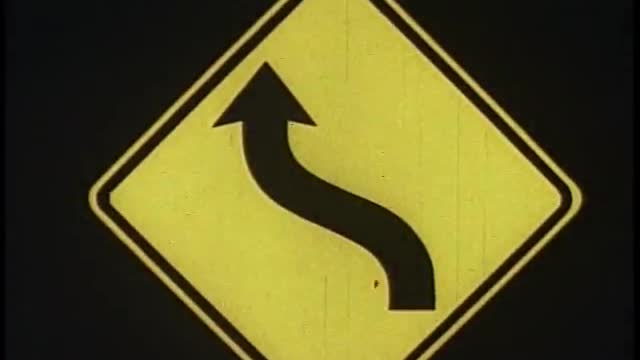Premium Only Content

We Drivers (1935 edition)
We Drivers (1935 edition)
by Handy (Jam) Organization
Publication date 1936
Usage Public DomainCreative Commons Licensepublicdomain
Topics Safety: Driving
Digitizing sponsor General Motors Corporation, Public Relations Staff
Early driving safety film showing good and bad sides of a driver's mind.
Shotlist
We Drivers was released as part of an industry-wide safety campaign throughout the Thirties. Two years earlier, in 1934, the first driver training courses began in American schools, and the film was no doubt made to be shown to pioneering driver ed students. In 1936, the Automotive Safety Foundation was organized, funded jointly by car manufacturers, tire companies, the oil industry and insurance firms. As Ed Cray put it in Chrome Colossus: General Motors and Its Times (New York: McGraw-Hill, 1980), "the foundation deflected criticism from the vehicle itself...". The Foundation lobbied for more and better roads, promoted mandatory state motor vehicle inspections (blaming accidents on motorists keeping their vehicles in poor mechanical condition), but ignored the design defects of automobiles.
Of 55 films distributed by the General Motors Film Library, We Drivers was the most popular. This, the first version, was shown in 7,000 theaters over ten months in 1936-37 and also seen by 24 million people in schools, institutions and community groups. Its technical complexity (including photography of models, full animation, animation over real photography, and technical animation, all in early three-strip Technicolor) necessitated an eleven-month production schedule. Later, it was remade at least four more times to update the look of the cars seen in every scene. A short booklet, also called We Drivers, was also made available by GM for "the safety, comfort and pleasure of the motoring public."
The strategy that We Drivers chooses to employ dramatizes safe vs. unsafe behavior as a struggle for good and evil within the mind of the all-too-human driver. In eight sequences, the animated characters "Reckless Rudolph" and "Sensible Sam", an earlier incarnation of the right path/wrong path "Goofus and Gallant", fight to outdo each other, interacting in the same frame as their host. The one-reeler ends with a boxing match: Sam K.O.'s Rudy, and the referee's long count becomes a recitation of short and sweet maxims, ending with an admonition to "Obey all laws!" Like the print advertising of the 1930s, often tending towards tabloid-type headlines and copy designed to grab readers who were defecting to the radio, this film filters its complex message through ten patronizing slogans. In the end this entertaining film, on the surface designed to teach self-control, becomes an instance of mind control.
Contents. An appeal for safe driving practices.
Opens with an animation of a prize fight between two cartoon characters, Reckless Rudolph and Sensible Sam. In the scenes that follow, the figures of Reckless Rudolph and Sensible Sam are superimposed on views of a real driver. Reckless Rudolph offers bad counsel, and Sensible Sam counteracts it with his good advice. A driver passes a car and almost collides with an oncoming vehicle. The commentator says that passing a car at 40 miles per hour is like passing 18 cars parked bumper to bumper and urges that drivers make sure they have sufficient clearance before passing. A giant character, Old Man Momentum, is introduced to symbolize the need for slackening speed at turns and descending hills in a lower gear. An airplane following a car around a curved speedway illustrates the need for banking roads to overcome centrifugal force.
A sequence on night driving is introduced by views of a man driving at high speed at night. Lights are dimmed in meeting cars. An animated diagram explains the term "overdriving your light." After a sleepy driver nearly collides with a parked truck, Sensible Sam prevails upon him to stop for the night. Need for special precautions under conditions of unusually low visibility is illustrated. In a fog a good driver reduces his speed, dims his lights, sounds his horn periodically, and keeps close to the right side of the road.
The commentator says that friction is an enemy of most moving parts of the automobile, but that it is necessary for stopping and starting. Sensible Sam cautiously feels his way along an icy sidewalk while Reckless Rudolph, proceeding carelessly, falls. A driver demonstrates "easy braking" in engaging the clutch in icy weather.
The significance of traffic signs is demonstrated by views of signs, each of which dissolves to an animated diagram of the situation it denotes. A motorist slows down on seeing a school-crossing sign and is able to avoid hitting a tardy child who dashes across his path. After the commentator says that the driver must never try to predict what the "other fellow" is about to do, a pedestrian walks out from between parked cars, is nearly hit, and is about to protest vigorously when he notices that he is driving the car himself. Animated diagrams explain the term "margin of safety." A daydreaming driver nearly collides with a car ahead.
The scene returns to the prize fight as Sensible Sam knocks out Reckless Rudolph. The referee enumerates ten safety rules.
Appraisal. Reported very good for illustrating safe driving practices. Found useful in giving students an appreciation of the automobile driver's responsibilities.
Teachers reported that the animated figures representing man's dual personality were very effective, and many students reported that they liked this type of presentation.
Photography is excellent, sound good.
Ken Smith sez: Reckless Rudolph and Sensible Sam, color cartoon characters, "represent the duel personalities in us all." They portray the bad and good consciences of a typical driver (they call him "boss"). Reckless seems intent on killing the poor guy with bad advice, while Sensible prefers to nag him like a nervous mother-in-law. This visually innovative film features beautiful color animation, a hairy, double-exposure giant ("Old Man Mountain Momentum") who pushes cars around, and one scene where the driver yells at himself in seamless split photography. Winner of the 1936 first place award from the National Safety Council. Definitely the most entertaining version of this film. At least three others were made -- in 1951, 1955, and 1962.
-
 3:12:37
3:12:37
Danny Polishchuk
10 hours agoTariffs and Trade Wars + Nick Rochefort | Low Value Mail #136
44.5K3 -
 2:04:40
2:04:40
I_Came_With_Fire_Podcast
12 hours agoCartels vs The United States, Fentanyls 2 Front WAR, and FTOs
23.9K -
 4:54
4:54
CryptoWrld
13 hours ago $1.81 earnedCrypto Startup Launches Tokenized US Treasury Bonds
26.5K4 -
 2:29:15
2:29:15
We Like Shooting
19 hours ago $1.14 earnedWe Like Shooting 596 (Gun Podcast)
19K -
 54:43
54:43
Kimberly Guilfoyle
12 hours agoThe Trump Effect: Mexico Folds, Live with Dinesh D’Souza & Chuck DeVore | Ep.193
102K34 -
 1:20:47
1:20:47
Redacted News
11 hours agoMexico CAVES to Trump over tariffs, USAID Shutdown, & Zelensky loses $200 billion | Redacted Live
183K467 -
 1:02:29
1:02:29
The StoneZONE with Roger Stone
7 hours agoIs GOP Sen. Bill Cassidy Playing Politics with RFK Jr. Vote as U.S. Faces Public Health Crisis?
34.7K5 -
 1:10:30
1:10:30
BIG NEM
10 hours ago📢 THE JOLLOF-OFF: The Battle for West African Cuisine! 🇳🇬🔥🇬🇭
30K4 -
 54:58
54:58
LFA TV
1 day agoThe Trade War Begins | TRUMPET DAILY 2.3.25 7pm
56.1K27 -
 11:08
11:08
Tundra Tactical
10 hours ago $1.12 earnedDead Air Silencers 10 YEARS of INNOVATION!
32.9K1